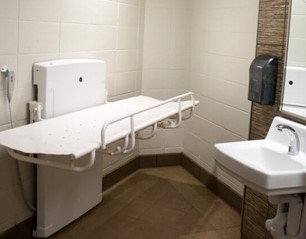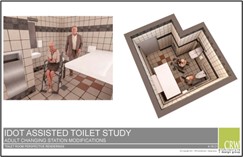BACKGROUND
The United States has had a long history of connecting people to various parts of the country through a network of highways, roads and bridges. Modes of travel have certainly evolved over the years, and with the development of the automobile it expanded the idea of constant movement around our cities and towns, road trips with friends, and family vacations around the country in a fraction of the time. It was not until the passage of the Americans with Disabilities Act (ADA) of 1990, when people with disabilities could enjoy the same amenities as an ambulatory person would. However, certain amenities such as adult changing stations remain relatively unavailable in public restrooms.

Photo: Adult-Sized Changing Table with adjustable height
Families and caregivers of people with disabilities want to participate in as many activities and outings as possible. At the same time, they must plan out or research their trip or daily activities to include accessible spaces along their path of travel, whether they are enjoying a movie, dining out, or going to a shopping center, the swimming pool, sporting events, summer camps, and more. Some families must also plan every detail of a road trip or vacation, taking into consideration the disability-friendly rest areas along a certain route or researching the most accommodating airports when flying, as well as accessibility accommodations at hotels/resorts.
States around the country have taken steps to address the need for adult changing stations in public spaces and accommodations, some even passing legislation for implementation at public rest areas, museums, libraries and government owned facilities. States like Arizona, California, Michigan, and Pennsylvania have already enacted legislation. However, states like Iowa, Ohio, Georgia and New Hampshire have proposed legislation in the past, but have taken no action on a formal bill.
Public accommodation does not only include accessible facilities, but it also implies that people with disabilities and their families have access to transportation that can accommodate their needs. A family may have immediate access to a personal vehicle or public transportation at home, but this can be a barrier when flying and not knowing if an accessible vehicle is available when arriving at their destination.
MAKING ACCOMODATION A REALITY

Photo: Iowa DOT, proposed family restroom re-configuration
The Iowa Legislature was unable to pass HF2097 in the 2020 session, however, Iowa DOT officials continued to move forward with the presented ideas, and to implement adult changing stations within many of the rest areas along Iowa’s highways. Working with the guidance of local advocacy groups and families, they had the opportunity “to resolve the issue of the availability of a dignified and respectful way to meet the basic sanitary needs of families” according to Iowa DOT’s Director of the Design Bureau,
Mike Kennerly, going on to say that “providing these accommodations was the right thing to do … knowing that something most people take for granted can be so difficult for some.” Iowa DOT has already begun working with an architectural firm to re-configure its existing family restrooms and retrofit an adult changing table within each modern rest area sites.

Photo: Kristin, Adam and Bronwyn Haar
Adam and Kristin Haar have experienced the harsh reality of changing their 10-year-old daughter, Bronwyn, on the floor of public restrooms when adequate changing stations are not available, leading to a lack of privacy, dignity and proper sanitation that most other families take for granted. This can be troublesome when a child grows to be too long or heavy for one person to safely lift or transfer onto a standard changing table, especially when there are no family restrooms available for both parents to assist their child. A standard changing table can accommodate a child approximately 35-40 inches long and up to a recommended 50-60 pounds but does not typically have an adjustable height – which puts many people with disabilities and their caregivers at a disadvantage. While an adult changing station can accommodate upwards of 400+ pounds and 75 inches, more than enough space for a growing child or mature adult.
Kristin indicates that installing “adult-size changing stations in family restrooms will allow persons with disabilities to travel more freely in their communities and beyond, knowing restroom [sanitary] needs will not be an issue.” Their family has tried to remain active, and recently took a vacation to Walt Disney World. Without proper planning and research, they would have never been able to make such a journey without these basic accommodations; however, as Bronwyn continues to grow, the availability of adult changing stations will dictate where their family can play and travel. She goes on to say, “I am proud that Iowa DOT has heard the plight of families like ours … the more public spaces and businesses that follow suit, the more inclusive life will be for everyone.”
SUMMARY
Public accommodation and accessibility remain a vital component to everyday life, especially for people with disabilities and their caregivers. With the constant expansion of roads and highway networks and air travel, people have a greater ability to explore their surroundings and travel farther than ever before. The recent attention from state Legislatures and Departments of Transportation to include adult-size changing stations within public spaces, museums, libraries and government-owned facilities, opens the door for people with disabilities to utilize the same amenities as those who are ambulatory. Without basic accommodations such as adult changing stations or accessible transportation, families and caregivers are left to choose between hours of planning and research to locate safe spaces while traveling, or to stay home and isolated from their communities and beyond.
The addition of adult changing stations in public spaces will allow families, like the Haars, to travel freely, visit new destinations and attend events with confidence and dignity without the added anxiety of not knowing if a certain location will be accessible or have the accommodations needed to keep their family safe, secure and sanitary.
RESOURCES
Transportation Matters, Iowa DOT
“New Changing Station Options in Iowa Rest Areas are a Game Changer for Families.”
McKnight’s Senior Living
“Several States Consider Requiring Adult Changing Stations in Certain Buildings.”
The Gazette
“Bill Would Require Adult Changing Stations at Iowa Rest Stops.”
This blog was written by Jeremy Johnson-Miller, Communications Manager for the National Aging & Disability Transportation Center and Easterseals, with special contribution by Kristin Haar.
Leave a Reply